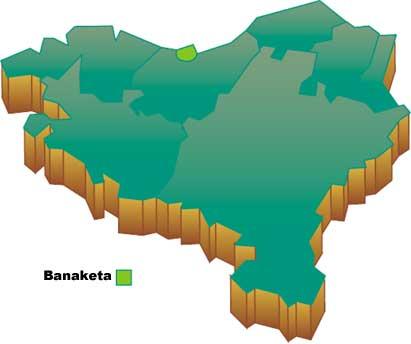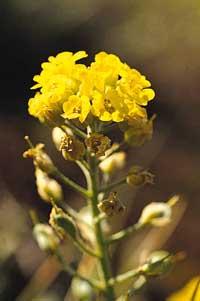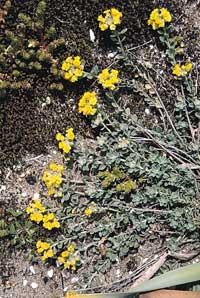Silence in our last dunes: Alyssum arenarium

The family formed by this singular plant is very represented in our flora, since within this family are known about 350 genera and about 3,500 species. In Euskal Herria more than 50 genera are known within this family, with 6 species among us.
The species Alyssum arenarium object of study on this occasion, as indicated by its scientific name, should be related to the sand, and it has it, since it is a inhabitant of the coastal dunes. The appearance of this plant, from medium to small, is durable. In the mobile sandy soils of the dunes it appears forming rosettes, some of them sterile or axes. Its small leaves are covered by starry hairs. The latter are usually in the shape of a spear and somewhat rounded. In the most tempting slaughterhouses that stand out from the rosettes appear numerous small yellow flowers at the beginning of spring. Their fruits are usually crispy, keeping 1-2 elliptic seeds in their inner lobes.

This alyssum, according to experts, can be part of an alpine group of the same genus, and some populations may be compared to low altitudes during the glaciation. Under this hypothesis, in the dunes, conditions similar to the dynamic soil that occurs in the mobile gravels of the mountainous summits. It should be noted that in the Pyrenees of Huesca is the plant of Alyssum cuneifolium, very close to this species, and that the population of Euskal Herria is closer to its characteristics than to that of Galicia. However, it will be necessary to carry out more and more profound studies to confirm this hypothesis.
Following the characteristics of this important species, this plant is endemic; it is located in the southeast of France and in the north of the peninsula. In the peninsula it is mentioned in very few places, while in Euskal Herria can be found in a single location. Very scarce in France, it is only located in the south of the Landes and is protected by law.
State botanists are working on the protection of the plant and, of course, in the Basque Autonomous Community and Navarre, we believe that it would be absolutely necessary to adopt any of these measures. Law on Conservation of Nature of the Autonomous Community of the Basque Country (16/1994), II “Threatened Species”. In chapter 48, where he says: “The Basque List of Endangered Species of Fauna and Flora will include species, subspecies or populations that require special protection measures. For these purposes, you must be classified in one of the following categories:
- “Endangered”. Limited to those who will have a long duration, following the motivating factors of the current situation.
- “Vulnerable”. Those in which the adverse factors that affect or affect their habitats, are not corrected immediately, at risk of becoming those of the previous category.
- “Raros”. This category will include unpopulated species or subspecies, in restricted geographical areas or in large territories.
- “Of special interest”. Not included in the previous categories but for their scientific, ecological or cultural value or for their uniqueness require special attention.
In view of its situation, and taking into account the law, we consider that the species under study Alyssum arenarium should be the category “Endangered” for the following reasons:
- In Euskal Herria, because it appears in a single dune,
- because the continuity and future of their habitat is not guaranteed, and
- Taking into account the situation and relevance of the ecosystems in which it is located and being a typical indicator of them, the set of which, together with it, are part of the psamofila vegetation, the rest of the living beings and the habitat itself are in serious danger.

But let's continue to analyze the law and paragraphs 49 and 50 say:
Chapter 49 Chapter 49
- When determining the category in which a species or subspecies should be classified, the existing risk situation in all its natural territory will be taken into account, regardless of the circumstances that may alter or improve the local situation.
- The endangered populations may be listed in a given place.
Chapter 50 Chapter 50
- The inclusion of a species or subspecies of population of fauna or flora in the “Basque List of Threatened Species of the Basque Country” will be subject to the following general prohibitions: · In the case of animals, perform any unauthorized action that has for object the sacrifice, capture, continuation or provocation of them. This prohibition includes the destruction of the cavities, offspring or eggs and habitats of these animals and, in particular, the revitalization, wintering, rest or feeding of them. · In the case of plants, destroy, cut, cut or pluck some part of the vegetation and perform any unauthorized action that leads to habitat destruction. · In the case of animals or plants listed in the classifications “in danger of extinction” or “vulnerable”, being alive or dead, naturalizing, transporting, selling, exhibiting, importing or exporting, as well as collecting specimens or vegetable parts and seeds, pollen and spores, except in the cases that are regulated.
- The Department of Agriculture and Fisheries will be responsible for listing species, subspecies and populations. To do this, you will take into account the previous report by the Advisory Council for the Conservation of Nature of the Basque Country. This report must be made before a month.
We already have information and tools. Now is the time to demonstrate the commitment, will, and attitude that has often been lacking. We will see...
Family: cruciferous Species: Alyssum arenarium Distribution: very rare Habitat: coastal dunes Medicinal herb: - - - - - - |





